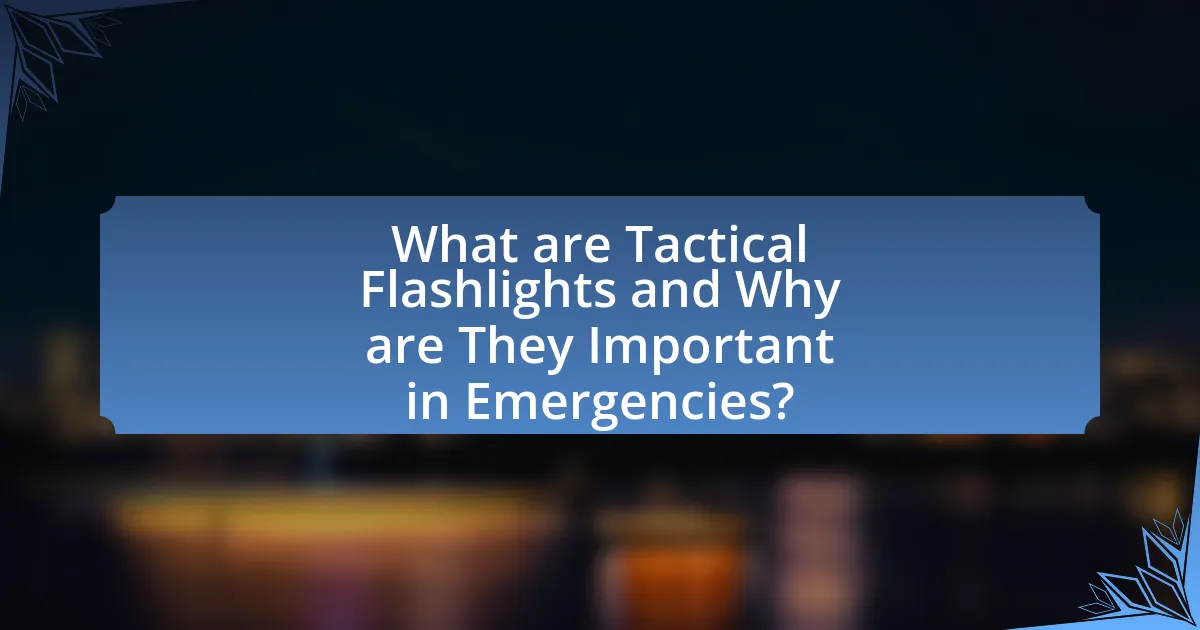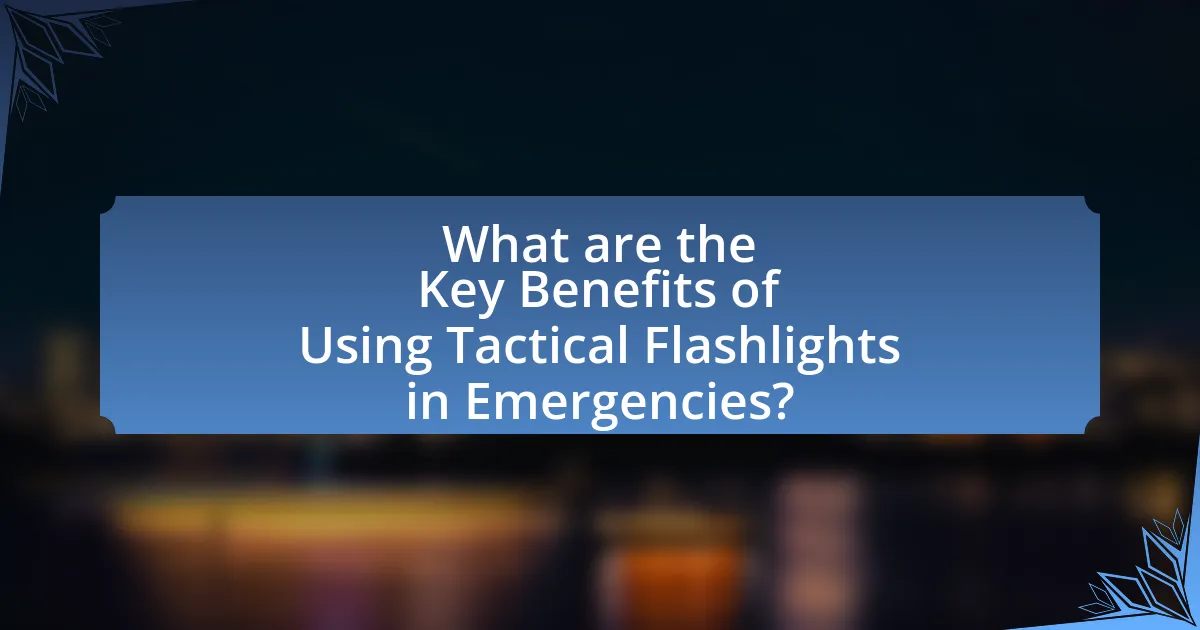Tactical flashlights are high-performance lighting devices essential for emergency situations due to their durability, brightness, and versatility. They differ from regular flashlights by offering features such as adjustable brightness levels, strobe functions, and rugged construction, making them reliable tools for both first responders and civilians. The article explores the critical role of tactical flashlights in enhancing visibility, ensuring safety, and aiding in search and rescue operations during crises. It also discusses key specifications to consider when selecting a tactical flashlight, including brightness, battery life, and durability, as well as best practices for effective use and maintenance in emergencies.

What are Tactical Flashlights and Why are They Important in Emergencies?
Tactical flashlights are high-performance lighting devices designed for use in critical situations, featuring durability, brightness, and versatility. They are important in emergencies because they provide reliable illumination, enabling individuals to navigate safely, signal for help, and assess situations effectively. Tactical flashlights often have features such as adjustable brightness levels, strobe functions for signaling, and rugged construction to withstand harsh conditions, making them essential tools for first responders and civilians alike during crises.
How do Tactical Flashlights differ from regular flashlights?
Tactical flashlights differ from regular flashlights primarily in their design, functionality, and durability. Tactical flashlights are built to withstand harsh conditions, often featuring robust materials like aircraft-grade aluminum, which enhances their resistance to impact and water. Additionally, they typically offer higher lumen outputs, allowing for brighter illumination, and often include features such as strobe modes for self-defense or signaling. Regular flashlights, in contrast, generally prioritize basic illumination without the advanced features or rugged construction found in tactical models. This distinction is crucial in emergency situations where reliability and versatility are paramount.
What features make Tactical Flashlights suitable for emergency situations?
Tactical flashlights are suitable for emergency situations due to their high brightness, durability, and versatility. High brightness, often exceeding 1000 lumens, ensures visibility in dark or hazardous environments, which is critical during emergencies. Durability features, such as impact resistance and water resistance (often rated to IPX7), allow them to withstand harsh conditions and rough handling. Additionally, many tactical flashlights offer multiple lighting modes, including strobe and SOS functions, which can signal for help or disorient threats. These features collectively enhance safety and effectiveness in urgent scenarios.
Why is brightness important in Tactical Flashlights during emergencies?
Brightness is crucial in tactical flashlights during emergencies because it enhances visibility and situational awareness in low-light conditions. High brightness levels allow users to illuminate large areas, identify potential hazards, and navigate safely, which is essential in urgent situations. For instance, tactical flashlights can emit over 1,000 lumens, providing sufficient light to spot dangers from a distance, thereby reducing the risk of accidents or injuries. This capability is particularly vital in emergencies where quick decision-making is necessary, as studies show that visibility directly impacts response times and overall safety.
What role do Tactical Flashlights play in various emergency scenarios?
Tactical flashlights serve a critical role in various emergency scenarios by providing reliable illumination, enhancing visibility, and ensuring safety. In situations such as power outages, natural disasters, or search and rescue operations, these flashlights offer bright, focused light that can penetrate darkness and highlight hazards. Their durability and often water-resistant features make them suitable for outdoor use in adverse conditions. Additionally, many tactical flashlights include strobe or SOS modes, which can signal for help or disorient potential threats, thereby increasing personal safety. The effectiveness of tactical flashlights in emergencies is supported by their widespread use among law enforcement and military personnel, who rely on them for operational readiness and situational awareness.
How can Tactical Flashlights assist in search and rescue operations?
Tactical flashlights assist in search and rescue operations by providing high-intensity illumination that enhances visibility in low-light conditions. Their powerful beams can penetrate darkness, allowing rescuers to locate victims more effectively and navigate challenging environments. Additionally, many tactical flashlights feature strobe functions that can signal for help or disorient potential threats, improving safety for both rescuers and those in need. The durability and water resistance of these flashlights ensure reliable performance in various weather conditions, which is crucial during emergencies.
Why are Tactical Flashlights essential for personal safety in dark environments?
Tactical flashlights are essential for personal safety in dark environments because they provide visibility and deterrence against potential threats. In low-light situations, the ability to illuminate surroundings allows individuals to identify hazards, navigate safely, and avoid dangerous encounters. Furthermore, the bright beam of a tactical flashlight can temporarily blind an assailant, giving the user a critical advantage to escape or defend themselves. Studies indicate that well-lit environments significantly reduce the likelihood of crime, as perpetrators are less likely to act in areas where they can be easily seen. Thus, tactical flashlights serve as both a practical tool for safety and a psychological deterrent against criminal activity.

What are the Key Benefits of Using Tactical Flashlights in Emergencies?
Tactical flashlights provide critical benefits in emergencies, including enhanced visibility, durability, and versatility. Enhanced visibility allows users to illuminate dark areas, which is essential for navigation and identifying hazards during emergencies. Durability ensures that these flashlights can withstand harsh conditions, as many tactical models are designed to be impact-resistant and water-resistant, making them reliable in various environments. Versatility is another key benefit, as tactical flashlights often feature multiple brightness settings and strobe functions, which can be used for signaling or self-defense. These features collectively make tactical flashlights indispensable tools in emergency situations, ensuring safety and effective response.
How do Tactical Flashlights enhance visibility and safety?
Tactical flashlights enhance visibility and safety by providing powerful illumination in low-light conditions, which is crucial during emergencies. These flashlights typically feature high lumen outputs, often exceeding 1,000 lumens, allowing users to see clearly in dark environments. Additionally, many tactical flashlights are designed with adjustable beam settings, enabling users to focus light on specific areas or create a wider floodlight effect. This versatility aids in identifying hazards and navigating safely. Furthermore, the robust construction of tactical flashlights often includes features such as water resistance and impact resistance, ensuring reliability in critical situations. The combination of high brightness, beam adjustability, and durability makes tactical flashlights essential tools for enhancing visibility and safety during emergencies.
What impact does improved visibility have on emergency response?
Improved visibility significantly enhances emergency response by enabling responders to assess situations quickly and accurately. When visibility is increased, emergency personnel can identify hazards, locate victims, and navigate challenging environments more effectively. Studies have shown that adequate lighting reduces response times by up to 30%, allowing for faster decision-making and intervention. Furthermore, improved visibility minimizes the risk of accidents among responders, as they can better see obstacles and potential dangers in their surroundings. This combination of quicker response and enhanced safety underscores the critical role of visibility in emergency situations.
How can Tactical Flashlights help prevent accidents in low-light situations?
Tactical flashlights help prevent accidents in low-light situations by providing focused illumination that enhances visibility and awareness. In environments where natural light is insufficient, such as during nighttime or in poorly lit areas, tactical flashlights allow individuals to clearly see obstacles, hazards, and potential dangers. Studies indicate that visibility significantly reduces the likelihood of accidents; for instance, a report from the National Safety Council highlights that proper lighting can decrease accident rates by up to 50% in low-light conditions. Thus, the use of tactical flashlights directly contributes to safer navigation and decision-making in emergencies.
What additional functionalities do Tactical Flashlights provide?
Tactical flashlights provide additional functionalities such as strobe lighting, adjustable brightness levels, and durability for extreme conditions. Strobe lighting can disorient potential threats, enhancing personal safety in emergency situations. Adjustable brightness levels allow users to conserve battery life or increase visibility as needed, making them versatile for various scenarios. Furthermore, tactical flashlights are often constructed from robust materials, ensuring they withstand harsh environments, which is crucial during emergencies. These features collectively enhance the effectiveness of tactical flashlights in critical situations.
How can strobe and SOS modes be beneficial in emergencies?
Strobe and SOS modes in tactical flashlights are beneficial in emergencies as they enhance visibility and signal distress effectively. The strobe mode produces a rapid flashing light that can disorient potential threats or attract attention from rescuers, making it a crucial tool for personal safety. The SOS mode, which emits a standardized distress signal, communicates the need for help over long distances, even in low visibility conditions. According to the U.S. Coast Guard, the SOS signal is universally recognized and can be crucial in life-threatening situations, ensuring that individuals can signal for assistance when they are unable to call for help verbally.
What advantages do durable materials offer in Tactical Flashlights?
Durable materials in tactical flashlights provide enhanced resistance to impact, weather, and corrosion, ensuring reliability in emergency situations. These materials, such as aircraft-grade aluminum or high-strength polymers, contribute to the flashlight’s longevity and performance under extreme conditions. For instance, tactical flashlights made from these durable materials can withstand drops from significant heights and operate effectively in rain or snow, which is critical during emergencies when reliability is paramount. Additionally, the use of durable materials often results in a lightweight design, making the flashlight easier to carry and handle in urgent scenarios.

How to Choose the Right Tactical Flashlight for Emergency Situations?
To choose the right tactical flashlight for emergency situations, prioritize brightness, durability, and battery life. A flashlight with at least 300 lumens is effective for illuminating dark areas, while a rugged, water-resistant design ensures it can withstand harsh conditions. Additionally, selecting a flashlight with a long battery life or rechargeable options is crucial for reliability during emergencies. Research indicates that tactical flashlights with these features significantly enhance visibility and safety in critical situations, making them essential tools for preparedness.
What specifications should you consider when selecting a Tactical Flashlight?
When selecting a tactical flashlight, consider specifications such as brightness measured in lumens, battery life, durability rating (such as IPX for water resistance), beam distance, and size/weight for portability. Brightness is crucial as it determines visibility; for instance, a flashlight with 500 lumens can illuminate a wide area effectively. Battery life affects how long the flashlight can be used before needing a recharge or battery replacement, with many tactical flashlights offering several hours of continuous use. Durability ratings indicate how well the flashlight can withstand harsh conditions; an IPX7 rating means it can be submerged in water up to 1 meter for 30 minutes. Beam distance is important for targeting specific areas, with some tactical flashlights capable of projecting light over 200 meters. Lastly, size and weight influence ease of carry, with compact models being more convenient for everyday carry. These specifications ensure that the flashlight meets the demands of emergency situations effectively.
How does battery life affect the usability of Tactical Flashlights in emergencies?
Battery life significantly impacts the usability of tactical flashlights in emergencies by determining how long the flashlight can provide illumination when needed most. In critical situations, such as power outages or search and rescue operations, a flashlight with a short battery life may fail to function when it is most essential, potentially compromising safety and effectiveness. For instance, a tactical flashlight with a battery life of only one hour may not be sufficient for prolonged emergencies, whereas one with a battery life of several hours or more ensures continuous visibility and reliability. Therefore, the longevity of the battery directly correlates with the flashlight’s ability to serve its purpose effectively during urgent scenarios.
What is the significance of size and weight in Tactical Flashlight selection?
The significance of size and weight in Tactical Flashlight selection lies in their impact on portability and usability. A compact and lightweight flashlight enhances ease of carry, making it more accessible during emergencies when quick deployment is crucial. For instance, tactical flashlights often weigh between 2 to 6 ounces and are designed to fit comfortably in a pocket or attach to gear, allowing for hands-free operation. This portability is essential for first responders and individuals in crisis situations, as it enables them to maintain mobility while having reliable illumination readily available. Additionally, the size can influence the flashlight’s beam distance and battery capacity; smaller models may sacrifice some brightness or runtime for convenience, which is a critical consideration in emergency scenarios where both visibility and endurance are needed.
What are the best practices for using Tactical Flashlights in emergencies?
The best practices for using tactical flashlights in emergencies include ensuring the flashlight is fully charged or has fresh batteries, using a high lumen output for maximum visibility, and employing strobe or SOS modes to signal for help. A fully charged flashlight provides reliable illumination, which is critical in low-light situations. High lumen output, typically ranging from 200 to 1000 lumens, enhances visibility, allowing users to navigate safely and identify hazards. Utilizing strobe or SOS modes can attract attention from rescuers, as these features are effective in signaling distress. Additionally, keeping the flashlight accessible and familiarizing oneself with its functions before an emergency can significantly improve response time and effectiveness.
How can you effectively maintain your Tactical Flashlight for reliability?
To effectively maintain your tactical flashlight for reliability, regularly inspect and clean it to ensure optimal performance. This includes checking the battery for corrosion, replacing it as needed, and cleaning the lens and body with a soft cloth to remove dirt and debris. Additionally, storing the flashlight in a cool, dry place prevents damage from extreme temperatures and moisture. Regular maintenance, such as tightening loose parts and ensuring the O-rings are intact, enhances the flashlight’s durability and functionality, which is crucial in emergency situations where reliability is paramount.
What tips can enhance the effectiveness of Tactical Flashlights during emergencies?
To enhance the effectiveness of tactical flashlights during emergencies, users should ensure they select models with high lumen output, as brighter lights improve visibility in critical situations. Additionally, utilizing features such as strobe modes can disorient potential threats and signal for help. Regular maintenance, including checking battery levels and functionality, is essential to ensure reliability when needed. Research indicates that tactical flashlights with durable, water-resistant designs perform better in adverse conditions, making them more effective in emergencies.


